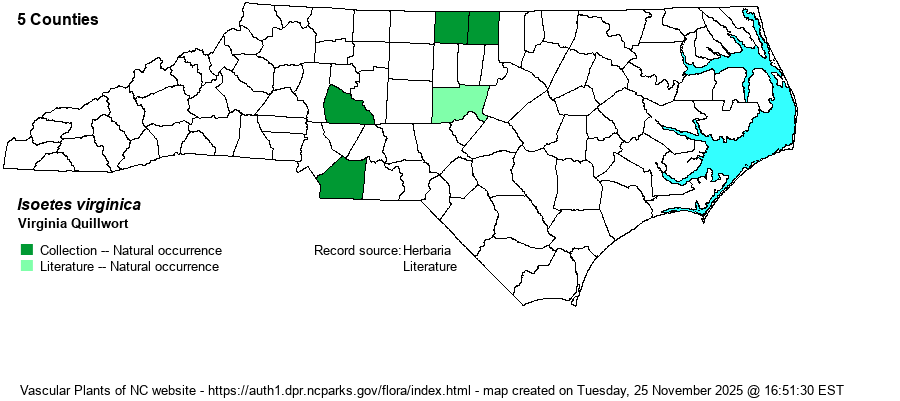| Section 1 » Family Isoetaceae |
Show/Hide Synonym
| taxonName | relationship | relatedTaxonName | relatedTaxonRefText | relComments |
|---|
|
|
|
| Isoetes virginica | < | Isoetes melanopoda | Radford, Ahles, and Bell (1968) | | | Isoetes virginica | < | Isoetes virginica | Gleason and Cronquist (1991) | | | Isoetes virginica | < | Isoetes virginica | Fernald (1950) | | | Isoetes virginica | < | Isoetes virginica | Flora of North America (1993b, 1997, 2000, 2002a, 2002b, 2003a, 2004b, 2005, 2006a, 2006b, 2006c, 2007a, 2009, 2010) | | | Isoetes virginica | < | Isoetes virginica | Gleason (1952) | | | Isoetes virginica | < | Isoetes virginica | Wofford (1989) | (also see I. piedmontana) | | Source: Weakley's Flora |
|
| Author | Pfeiffer | |
| Distribution | Present only in the eastern and central Piedmont, from Union County north to Caswell and Person counties. Franklin County records prove to be I. piedmontana.
This is a highly limited species in overall range, occurring only in central VA and central NC.
| |
| Abundance | Vey rare and declining. There are specimens from four counties, plus an extirpated report from another (Chatham County). However, only one site in Caswell County is still considered extant (at least though 2006) in the NCNHP database. Why this species is only listed by the NCNHP as Significantly Rare, and also not listed by the State and the USFWS as Endangered or Threatened is a puzzle and is quite disturbing. This species clearly needs to be listed as Endangered in NC, with only one currently known population. | |
| Habitat | This species is found in damp to wet ground along wooded seepages and creeks, as well as in upland depression swamps. | |
| Phenology | Fruits from July to September. | |
| Identification | All Isoetes species are quite grass-like, with numerous very slender and grass-like leaves growing from a common base. Most importantly, they are swollen at the base, where the megaspores are present, the key structure for separation of species. The leaves are terete (rounded) and hollow. For identification, see the key in Weakley (2018). | |
| Taxonomic Comments | This species was included within I. melanopoda in older references, such as in RAB (1968).
All Isoetes species are quite grass-like, with numerous very slender and grass-like leaves growing from a common base. Most importantly, they are swollen at the base, where the megaspores are present, the key structure for separation of species. The leaves are terete (rounded) and hollow. For identification, see the key in Weakley (2018). | |
| Other Common Name(s) | None | |
| State Rank | S1 | |
| Global Rank | G1 | |
| State Status | SR-L | |
| US Status | | |
| USACE-agcp | | |
| USACE-emp | OBL link |

